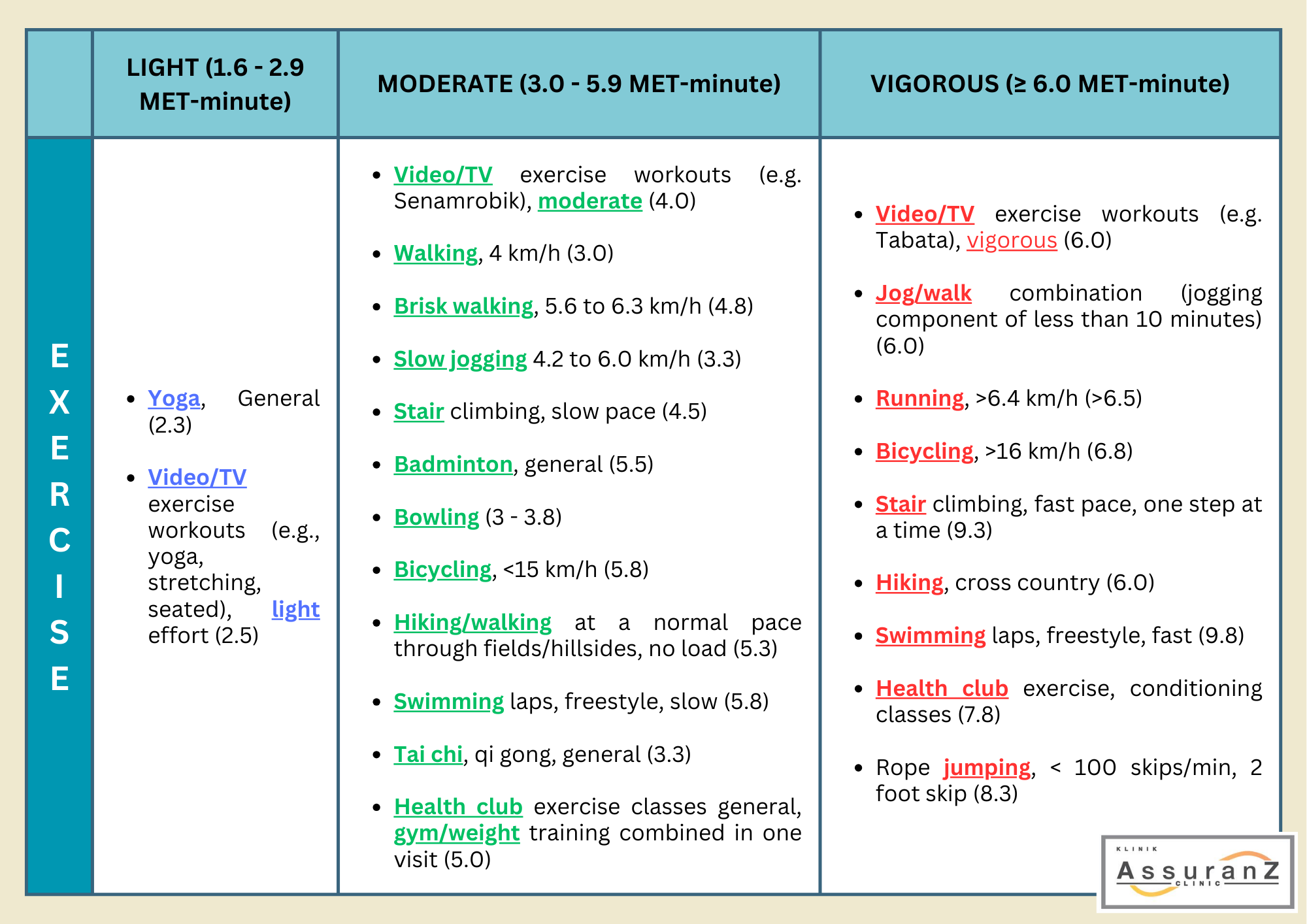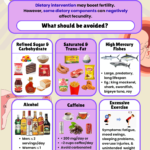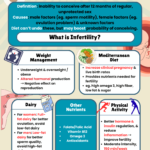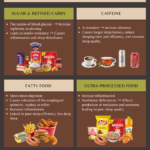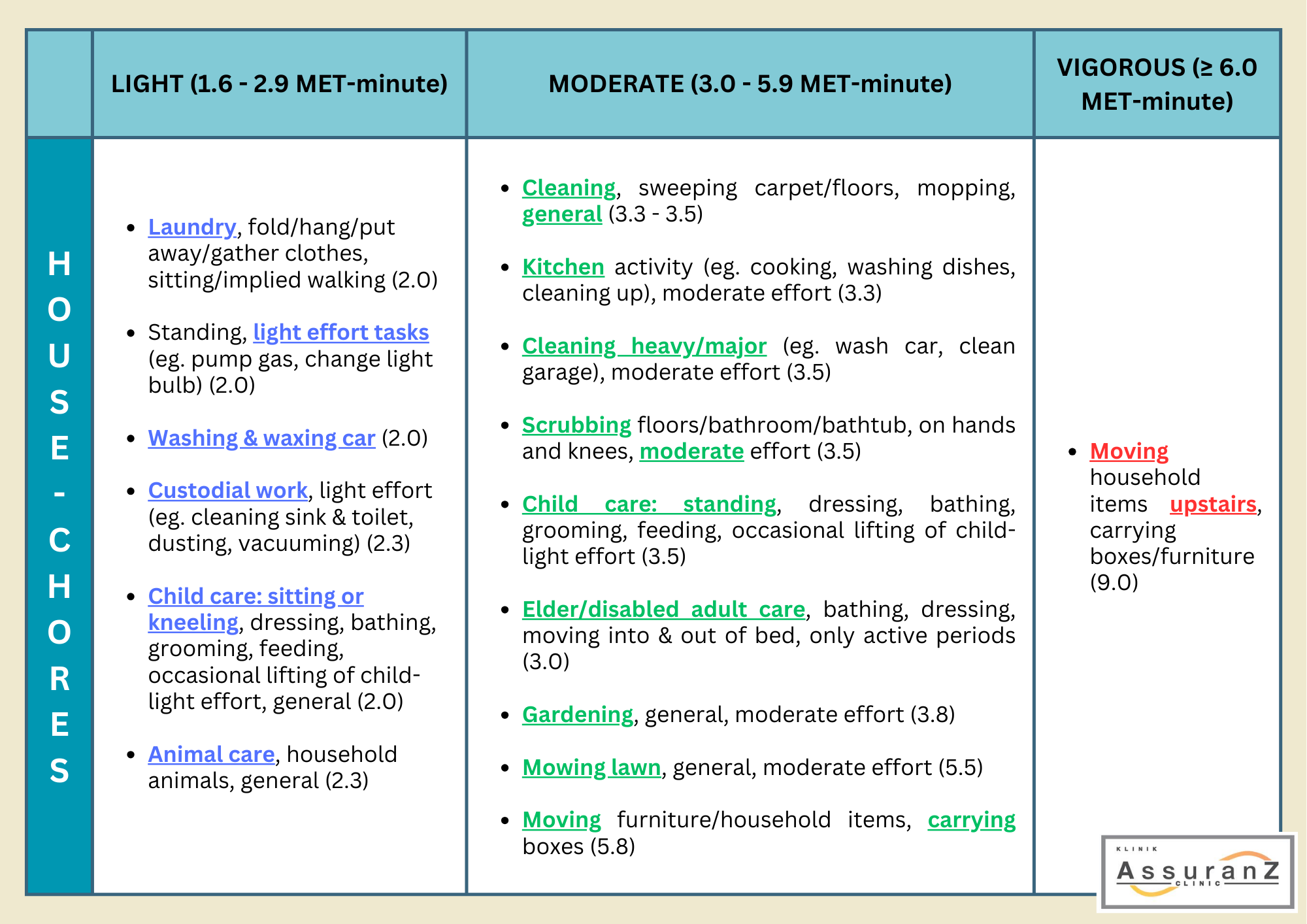
Physical activity refers to any movement of the body that is produced by the skeletal muscles which causes energy burning. Physical activity can be divided into various domains, namely leisure-time, occupation, education, household and transportation. Exercise, one of the subset of physical activity under leisure-time, is physical activity that is planned, structured, repetitive and with purpose, that is to improve and maintain health, physical fitness and performance level. It is commonly known that regular exercise provides many health benefits including -and not limited to- weight loss, reduced stress level, and reduced risk of cardiovascular diseases, diabetes and cancer.
身体活动是指由骨骼肌产生的任何能量消耗的身体运动。身体活动可分为多个领域,包括休闲时间、职业、教育、家务及交通。运动是休闲时间身体活动的一个类别,特指有计划、有结构、重复且有目的的身体活动,旨在改善和维持健康、体能和表现水平。众所周知,规律的运动带来了许多健康益处,包括但不限于减重、减轻压力及降低罹患心血管疾病、糖尿病和癌症的风险。
To obtain the benefits and to reduce the risk of aforementioned health risks, many guidelines such as the World Health Organization, and the Malaysian Dietary Guidelines have stated that one should engage in physical activity, either moderate intensity for at least 150 minutes per week, or vigorous intensity for at least 75 minutes per week, or a combination of both. Unfortunately, many people nowadays engage in sedentary behavior due to limited available space or location for exercise, time constraint, occupational sedentary behavior like office work, excessive engagement with technology like television and gadgets, financial resources etcetera As a result, there has been an increase in health problems related to physical inactivity such as insulin resistance, obesity and impaired lipid metabolism.
为了获得健康益处并降低上述健康风险,许多指南,如世界卫生组织和马来西亚膳食指南建议每周进行身体活动,至少150分钟中等强度的运动,或至少75分钟高强度的运动,或者两者结合。然而,许多人由于空间有限、时间紧迫、职业久坐(如办公室工作)、过度依赖科技产品(如电视机和电子设备)以及财务资源等原因,导致久坐行为普遍增加。因此,与身体不活动相关的健康问题,如胰岛素抵抗、肥胖和脂质代谢障碍等问题也有所增加。
Research has found that physical activity, whether in structured or unstructured form proved to be good for health. This includes things that we do daily, that is house-chores; for instance, cleaning, gardening, repair work, caring for children, elderly, disabled and pets. However, can house-chores really match and replace exercise in terms of fitness and health-related improvement?
研究发现,无论有组织或无组织的身体活动对健康都是有益的。这包括我们日常所进行的家务,例如清洁、园艺、修理工作、以及照顾儿童、老人、残疾人和宠物。然而,家务劳动在健身和健康改善方面真的能够与运动相匹配或替代吗?
The research in this area is sparse and the findings vary. Nonetheless, a study stated that while most house-chores within the population are generally low in intensity, it is possible to achieve the recommended moderate-intensity physical activity level through housework alone when it is fully performed as exercise. One research has found that when household chores are systematically planned, implemented and monitored to substitute a regular exercise regime, they have the same advantage as the traditional exercise in terms of fitness although they are not associated with weight loss among adolescents. Another study finds that housework engagement within elderly population is positively associated with physical and mental wellbeing. Furthermore, replacing an hour of sitting daily with a similar amount of activity, including non-exercise activities such as gardening and walking is associated with reduced all-cause mortality according to a research.
该领域的研究相对较少,结果各异。然而,一项研究指出,虽然大多数人群中的家务劳动强度通常较低,但当家务劳动完全按照运动的方式进行时,确实可以达到所推荐的中等强度身体活动水平。另一项研究发现,当家务劳动经过有序安排、实施和监控,以替代定期运动时,在健身方面具有与传统运动相同的优势,尽管这与青少年的减重无关。还有一项研究显示,老年人参与家务劳动与心理健康呈正相关。此外,根据研究,每天将一小时坐着的时间替换为同等时间的活动,如园艺和步行等非身体活动,与降低全因死亡率相关。
The levels of activity can be categorized based on the Metabolic equivalent of task (MET), in which 1 MET is equivalent to the energy expended when an individual is seated at rest. For example, 2 METs means that the energy expenditure of the activity done is 2 times of when one is seated at rest. Further description for METs level are as below:
活动强度可以根据代谢当量(MET)进行分类,其中1 MET等于个体静坐休息时所消耗的能量。例如,2 METs意味着该活动的能量消耗是静坐时的两倍。MET水平的进一步描述如下:
- Light (1.6 – 2.9 MET-minute): No noticeable changes in breathing (eg. walking, cooking)
轻度(1.6 – 2.9 MET-分钟):呼吸没有明显变化(例如:走路、做饭)
- Moderate (3.0 – 5.9 MET-minute): Increase heart rate and breathing, but able to maintain conversation uninterrupted (eg. stair climbing, brisk walking)
中等(3.0 – 5.9 MET-分钟):心率和呼吸增加,但能够保持不间断的交谈(例如:爬山、快走)
- Vigorous (>= 6.0 MET-minute): Conversation cannot be maintained uninterrupted (eg. fast cycling, jogging)
剧烈(>= 6.0 MET-分钟):无法保持不间断的交谈(例如:快速骑行、慢跑)
One should achieve between 500 to 1000 METs per week (MET-minute x minutes of exercise per week; for example, if an individual gardens [3.8 MET-minutes] for 3 hours in a week [a total of 180 minutes per week], they will achieve 684 METs per week) in order to hit the minimum recommended physical activity of 150 minutes per week. The figure shows the comparison of activity levels between exercise and common house-chores divided into the respective METs.
一个人每周应达到500到1000 METs(MET-分钟 x每周活动分钟数);例如,如果一个人每周花3小时(总共180分钟)进行园艺活动【3.8 MET-分钟】,那么他们每周将达到684 METs,以满足每周150分钟身体活动的最低推荐。该图显示了活动和常见家务活动的活动水平比较,并将其划分为相应的METs。
In conclusion, while traditional exercise provides greater benefit than household related chores, housework can still be done to achieve at least the minimal level of recommended physical activity to improve fitness and health for those with financial, time and other constraints. Keep in mind that in order to obtain said benefits, the house-chores should be done systematically in terms of structure, duration and activity level.
总之,尽管传统运动所提供的益处大于家务劳动,但对于面临经济、时间和其他限制的人来说,家务活动仍然可以帮助达到至少推荐的最低身体活动水平,从而改善健康和体能。值得注意的是,为了获得这些益处,家务活动应在结构、持续时间和强度上有系统地进行。
References: Herrmann SD et al (2024), NIH NLM US (2024), Chu L et al (2023), Nik-Nasir NM et al (2022), HSPH US (2022), Tanucan JCM et al (2022), WHO (2004, 2020 & 2021), MOH MY (2021), Ejechi EO & Esiri MO (2021), Singh R et al (2020), Matthews CE et al (2015), Verschuren O et al (2014).
资料来源:Herrmann SD et al (2024), NIH NLM US (2024), Chu L et al (2023), Nik-Nasir NM et al (2022), HSPH US (2022), Tanucan JCM et al (2022), WHO (2004, 2020 & 2021), MOH MY (2021), Ejechi EO & Esiri MO (2021), Singh R et al (2020), Matthews CE et al (2015), Verschuren O et al (2014)。

